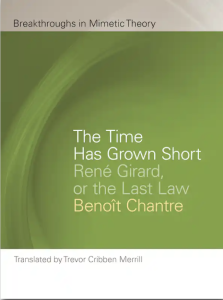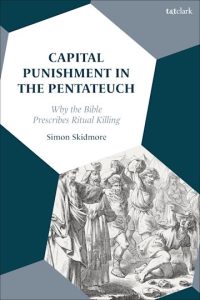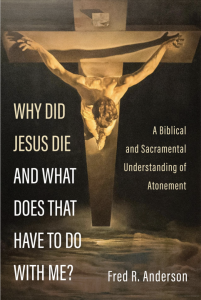In this issue: News about COV&R’s 2023 annual meeting and COV&R at the AAR, including the calls for papers, plus other forthcoming events and an introduction to COV&R partner Sharing Sacred Spaces.

Contents
Editor’s Column: Curtis Gruenler, The Future of Mimetic Theory (in Literary Studies, for Instance)
Letter from President: Martha Reineke, Sharing Sacred Spaces
COV&R Annual Meeting, Paris, France, June 14-17
Analogy, Desire, and Imitation, Maynooth, Ireland, April 28-29, 2023
Mimesis Scandinavia, Stockholm, Sweden, May 12-13, 2023
Theology & Peace Annual Gathering, Chicago, IL, October 5-8, 2023
René Girard Centennial Celebration, Washington, DC, October 13, 2023
COV&R at the American Academy of Religion, San Antonio, TX, November 18-21, 2023
Musings from the Executive Secretary
Paris, We Are Coming!
Some Practical Advice
Nikolaus Wandinger
 This time I abstain from “musing” in order to simply tell you how much I am looking forward to going to Paris from June 14-17 and participating in this year’s 100-year celebration of René Girard, which is also dedicated to looking into the future of mimetic theory. Furthermore, I want to give you some facts and figures and some useful information.
This time I abstain from “musing” in order to simply tell you how much I am looking forward to going to Paris from June 14-17 and participating in this year’s 100-year celebration of René Girard, which is also dedicated to looking into the future of mimetic theory. Furthermore, I want to give you some facts and figures and some useful information.
I think it is more than fitting to return to Girard’s country of birth in the year of his centenary. This is made possible by the generous offer of Benoît Chantre, the Association Recherches Mimétiques (ARM), and the Catholic Institute of Paris, represented by Camille Riquier, Dean of the Faculty of Philosophy, to host us. COV&R plenaries are enhanced by our hosts’ connections, and this tradition continues this year. Members of the Paris organizing team, Benoît Chantre and Paul Dumouchel, have invited and assembled an intriguing slate of plenary speakers who will be introduced with some detail on our website shortly.
The Catholic Institute lies in the heart of Paris. Founded in 1875, it is the inheritor of the medieval liberal arts colleges and stands in the tradition of the Sorbonne. With 900 professors and 10,000 students from 60 countries, it is a place of highest quality academic learning and education. It is an ideal place to come together with ARM, COV&R’s French partner organization.
For now, let me offer some recommendations that might be useful for your trip to Paris: As Paris is a very sought-after tourist destination, booking accommodation early is highly advisable. Please check for the religious house of your choice and book soon, or look out for a hotel near the conference venue. We have heard from COV&R members that some of the smaller hotels near the conference site are sold out already. If you hope to stay within walking distance at reasonably-priced hotels, you should make reservations as soon as possible. However, the Paris Metro system will get you to the conference also from other hotels in the 5th, 6th, or 7th arrondissement.
If you plan to submit a proposal, you might find it helpful to know that our aim is to review paper proposals quickly and that we should be able to notify you of the status of your proposal within 7-10 days of submission. We are looking forward to many interesting proposals.
You can find all the important information with links to register here.
See you in Paris,
Niki
Editor’s Column
The Future of Mimetic Theory
(in Literary Studies, for Instance)
Curtis Gruenler

Registration for COV&R’s annual meeting in Paris, June 14-17, is open. Full information, including the call for papers, the Raymund Schwager Essay Contest, and travel grants, is available here. Abstracts are due April 15. The registration page is here. Be sure to see Executive Secretary Niki Wandiger’s recommendations in this issue. We are also delighted to have a response by Benoît Chantre, president of the Association Recherches Mimétiques and one of the organizers of the meeting, to Anthony Bartlett’s review of his recent book, The Time Has Grown Short.
During fall semester for the past decade, I have taught an upper-level undergraduate introduction to literary theory that devotes a week to René Girard and mimetic theory. I have always been encouraged by how powerful students find it. When I ask at the end of the term which literary approaches interested them most, they will mention others, like deconstruction, disability theory, or, most recently, post-humanism. And then someone will often say something like, “And mimetic theory—I’m seeing that everywhere.”
This past fall, I had the opportunity, with the support of the Global Liberal Arts Alliance, to connect my course with a similar course being taught at Forman Christian College in Lahore, Pakistan, by Dr. Qurratulaen Liaqat. Part of our connection was guest lectures in each other’s courses. She’s the one who got my students interested in post-humanism, and she tells me that my lecture on mimetic theory had a similar effect on her students. Of course I was excited to have the chance to put Girard on the map of literary theory as it is known on the other side of the globe by one group of students.
Girard was commonly included on the map of literary theory as it was known in English-speaking academia during theory’s heyday in the 1980s. The younger faculty in my graduate program in the 1990s were likely to have Violence and the Sacred on their shelves. I doubt that would be true of new faculty now, for reasons that COV&R members are likely to be familiar with. Google alerts me to mentions of mimetic theory around the world (which in December mostly had to do with season 2, episode 6, of HBO Max’s popular White Lotus), but they are all non-academic. As we approach our summer meeting in Paris, with its focus on Girard’s legacy and the future of mimetic theory, my sense is that the time is ripe for Girard to return to greater prominence on the map of literary studies, and not just as one approach among others.
In the increasing eclecticism and politicization of literary studies, mimetic theory has potential to redraw the field in order to give it coherence and keep various other approaches in conversation with each other. Girard’s own work provides starting points for dialogue with fundamental work on language, the legacies of influential thinkers like Marx, Nietzsche, and Freud, and the work of his major French contemporaries. His value for understanding what Geoff Shullenberger has called “the rise of victim power” offers perspective on identity-oriented theories, from feminism and post-colonialism to disability studies. Perhaps the challenge is to envision how mimetic theory could be, not a last word on other approaches, but a generative framework for thinking about them together. Such a challenge would best be met by a group of mimetic theorists working together, perhaps to provide contributions that develop particular conversations. If anyone would be interested in such a collaborative project, please let me know. I would love to talk to you in Paris!
News
March 1 is the deadline for proposals for the COV&R sessions at the annual meeting of the American Academy of Religion and the Society for Biblical Literature, to be held in San Antonio, Texas, November 18-21. The call for proposals is available here.
COV&R members receive a discount on volumes published in two Michigan State University Press, Breakthroughs in Mimetic Theory and Studies in Violence, Mimesis & Culture. A discount of 20% is currently available on the volumes published in 2022: The Time Has Grown Short: René Girard, or the Last Law by Benoît Chantre, translated by Trevor Cribben Merrill; Toward an Islamic Theology of Nonviolence: In Dialogue with René Girard by Adnane Mokrani; and Jean-Pierre Dupuy’s How to Think about Catastrophe: Toward a Theory of Enlightened Doomsaying. In addition, a 30% discount is available on selected titles from the backlist with a purchase of three or more. For more information, please see this page in the members section of the COV&R website. This spring, watch for Alterity by Jean-Michel Oughourlian, translated by Andrew McKenna, and Violence and the Oedipal Unconscious, vol. 1: The Catharsis Hypothesis, by Nidesh Lawtoo. Discounts for these volumes will be announced.
The Lumen Christi Institute has announced a summer seminar for undergraduate students, “The Thought of René Girard: Understanding the Faith in a Secular Age.” As of this writing the dates and location are not yet available.
Revista Interdisciplinar De Teoría Mimética. Xiphias Gladius has announced a call for papers on the theme “New radicalities, new victims. Approaching the current phenomena of radicalization.” Submissions are due 1 June 2023. The 2022 volume, on the theme “Romantic lie and novelistic truth 60 years later,” celebrating the anniversary of René Girard’s first book, is available online.
In January, a group hosted by Julie Shinnick began reading aloud Gil Bailie’s Violence Unveiled: Humanity at the Crossroads over Zoom. All are welcome to attend. Please email Julie if you are interested.
Due out this spring from Penguin is Cynthia Haven’s selection of “essential writings” from Girard, All Desire Is a Desire for Being.
Letter From The President
Sharing Sacred Spaces
Martha Reineke

The latest installment in my “getting to know you” conversations with COV&R’s partner organizations features our newest partner: Sharing Sacred Spaces (SSS). Its executive director is long-time COV&R member Vanessa Avery. I welcome the opportunity to share with all of you what I have learned about this highly innovative organization led by a committed practitioner of mimetic theory.
SSS is an organization which works on behalf of positive social change by “focusing on vehicles of architecture and space to bring people together in a compelling, non-threatening way.” Unique among non-profit organizations with a mission of promoting interfaith and intercultural understanding is SSS’s use of architecture as a primary mechanism in community-building. Vanessa comments that in SSS “walls speak,” sharing meaning, culture, and history with visitors. Through SSS programming, communities build “trust and solidarity and pledge to love and protect their neighbors across difference.” SSS “is a safe space, a peaceful center amid rivalry or disagreement.”
In the cities in which SSS has developed programs, eight congregations commit to one year of intentional interactions across difference: visiting each other’s sacred sites, listening to each other in planned exercises, and engaging in dialogue. Cohorts have completed the process in Chicago, Toronto, New Haven, and Stamford, and programs are launching in northern Virginia and Dallas. New settings for learning are being explored, including a self-paced online course.
In acknowledgement of the program’s success in creating transformational change and “local pockets of peace” that contrast with rivalrous spaces that so often occupy our attention, SSS has received an award from the American Institute of Architects for facilitating positive community engagement. Vanessa finds that, by focusing programming on architecture, people of different races, ethnicities, and religions are brought together in supportive ways that build trust.

Vanessa arrived at her leadership position with a dual background in the academic study of religion, including mimetic theory, and in diversity training leadership. She observed that religion was typically not addressed in diversity, equity, and inclusion (DEI) initiatives, largely because of an absence of knowledge, the feeling that religion was a private matter, and even the inclination to dismiss religion as a substantive workplace issue. Companies have become more open to religious DEI in recent years, but there is still a long way to go. Vanessa brought her own experiences as a religious minority into her DEI work training companies on how to understand religion and its impact in the workplace, common areas of misunderstanding, and ways to open dialogue. Throughout her myriad experiences in the workplace or in the classroom, she recognized familiar patterns of “othering”: if religious minorities were recognized, there was a burden on them to represent an entire group; other times, difference might be acknowledged but was subsumed by the majority (which led to classes being opened in prayer “in the name of Jesus”). At SSS, intentional practices focus on deep listening to generate inclusion and belonging, and to create a space where “othering” is obsolete.
Vanessa welcomes opportunities that may open as a result of SSS’s partnership with COV&R. She values our shared commitment to understanding the human condition, building awareness of it, and implementing this awareness for a better world. She would like to see COV&R partners work together to bring greater visibility to each other’s work. Sharing resources, especially those resulting in digital products outlets, would enable COV&R partners to reach more people.
Sharing Sacred Spaces joins a slate of partner organizations that amplify mimetic theory in varied ways among a wide range of audiences and appreciative learners. Although Vanessa is well known to many COV&R members, we are delighted to have an opportunity to get to know her in her new leadership role.
Forthcoming Events
COV&R Annual Meeting
Partnering with Association Recherches Mimétiques
The Catholic Institute of Paris
June 14-17, 2023
A Celebration of René Girard’s 100th Birthday:
The Future of Mimetic Theory

Full information, including plenary speakers, the call for papers, the Raymund Schwager Essay Contest, and travel grants, is available here. Abstracts are due April 15. The registration page is here. Be sure to see Executive Secretary Niki Wandiger’s recommendations in this issue.
Analogy, Desire, and Imitation
St. Patrick’s Pontifical University, Maynooth, Ireland
April 28-29, 2023
 Speakers at this international workshop will include William Desmond, Cyril O’Regan, John Betz, Grant Kaplan, Wolfgang Palaver, Michael Kirwan, Joshua Furnal, and Philip John Paul Gonzales. Information and registration is available here.
Speakers at this international workshop will include William Desmond, Cyril O’Regan, John Betz, Grant Kaplan, Wolfgang Palaver, Michael Kirwan, Joshua Furnal, and Philip John Paul Gonzales. Information and registration is available here.
Mimesis Scandinavia
Stockholm, Sweden
May 12-13, 2023
 Scheduled participants include Per Bjørnar Grande, Klas A.M. Eriksson, William A. Johnsen, Ali Jones Alkazemi, Marina Kohnen Ludwigs, Anders Olsson, Annika Mörte Alling, Hanna Mäkelä, Charlotta Palmstierna Einarsson, Antti A. Sundberg, and Joakim Wrethed. For more information, please contact organizer Marina Kohnen Ludwigs.
Scheduled participants include Per Bjørnar Grande, Klas A.M. Eriksson, William A. Johnsen, Ali Jones Alkazemi, Marina Kohnen Ludwigs, Anders Olsson, Annika Mörte Alling, Hanna Mäkelä, Charlotta Palmstierna Einarsson, Antti A. Sundberg, and Joakim Wrethed. For more information, please contact organizer Marina Kohnen Ludwigs.
Theology & Peace Annual Gathering
Chicago, Illinois
October 5-8, 2023
 The meeting will be held at the Casa Iskali Our Lady of Guadalupe Campus located outside of Chicago, Illinois. More information will be available at the Theology & Peace website.
The meeting will be held at the Casa Iskali Our Lady of Guadalupe Campus located outside of Chicago, Illinois. More information will be available at the Theology & Peace website.
René Girard Centennial Celebration
Catholic University of America, Washington, DC
October 13, 2023

This is the 2023 Novitate conference, an annual meeting intended to explore new models of thought and desire. Abstract submissions are welcome from anyone who is interested in the work of Girard and how it relates to the theme “Be Not Conformed.” Conference presenters will have their registration fee waived and may receive an additional stipend for speaking. Abstracts are due May 15.
COV&R at the American Academy of Religion
San Antonio, Texas
November 18-21, 2023
 March 1 is the deadline for proposals for the COV&R sessions at the annual meeting of the American Academy of Religion and the Society for Biblical Literature, to be held in. The call for proposals is available here. The deadline is March 1.
March 1 is the deadline for proposals for the COV&R sessions at the annual meeting of the American Academy of Religion and the Society for Biblical Literature, to be held in. The call for proposals is available here. The deadline is March 1.
Book Reviews
For inquiries about writing a book review or submitting a book for review,
contact the book review editor, Matthew Packer.
The Time Has Grown Short: René Girard, or the Last Law
Anthony Bartlett and Benoît Chantre
 Benoît Chantre, Translated by Trever Cribben Merrill
Benoît Chantre, Translated by Trever Cribben Merrill
Breakthroughs in Mimetic Theory, Michigan State University Press, 2022
103 pages
Editor’s Note: Given the special circumstances attending the recent publication of The Time Has Grown Short: René Girard or the Last Law—namely, the closely collaborative partnership between Girard and Chantre and their spirit of dialogue in Girard’s last book Achever Clausewitz/Battling to the End and in the present work—we considered it fitting to invite Chantre to respond to Bartlett’s review. Both kindly agreed to the arrangement. Aside from a couple of minor editorial changes, the review and response are published here in their entirety. We note that Chantre’s reflections will be particularly interesting to readers looking forward to Chantre’s forthcoming intellectual biography of Girard.
Anthony Bartlett
Benoît Chantre has written a rich and essential book, one that is also exceptional in as much as he is the only person who could possibly have done it. The Time Has Grown Short, René Girard, or the Last Law traces and completes the arc of Girard’s thought from Chantre’s privileged position as trusted conversation partner in the final passes of Girard’s career. That climactic period and partnership produced Battling to the End, a book that bends vertiginously toward a catastrophic future, and yet hangs there trembling, in Abraham-before-Sodom hesitation, over an abyss it so relentlessly opens before us.
Chantre’s present book comes as a coda to Battling to the End, and it does so in a way that parallels the gesture of the original book, but with a dramatically different tone and content. The French title of Battling was “Achever Clausewitz,” which translates literally as completing or finishing Clausewitz, signaling a determined drawing out of the Prussian’s (mimetic) logic of war to its last extreme. In its own ironic and yet authentic way this present book is Achever Girard. Girard was not a theologian, but his anthropology of religion as the generative motor of humanity makes him an indelible companion of theology. And, more profoundly, he sees the biblical text as having an unparalleled role in the revelation and overturning of sacred, founding violence. Thus Girard, even at his most historically pessimistic is brushed by a breath of the good news, of eschatological possibility. It is this possibility that Chantre draws out of his Girardian dialogue, finishing off Girard with a quite surprising but totally integral messianic commentary.
To complete a theoretician or author, to come to the end of their thought, it is necessary to isolate critical aspects which were not taken to term in their original expression. In Clausewitz Girard identified “the duel” as the crucial element which needed to be given full weight through mimetic analysis. Chantre, for his part, identifies two motifs in Girard which bend the tide of his insight to what seems a quite different season and shape. The trust of the dialogue between the two partners validates bringing these motifs into play as authentic possibilities. But, more than this, it is the material of the dialogue itself—one that revolves around biblical revelation, its function and content—which itself underpins Chantre’s bold move. The character of revelation is not to be repressed—as in all those classic storylines of seeds and growth in the gospels—and Chantre’s “completion” is, I think, a matter of that dynamic. His ability to finish up the first Achever (Girard’s last work) is a product of the revelatory engine at work in the very discussions between him and his mentor. It is very much a case of an irrepressible leaven working in the mix.
Chantre begins by presenting three consecutive “syntheses” in Girard’s work. There is archaic religion and its engine of sacrifice. There is messianic religion (prophetic and Christian), constituting a demystification of the archaic. And, finally, there is what he calls a “catholic” synthesis which is not denominational/identarian but “operative.” This third synthesis holds together the first two and offers a resolution, uniting two “untenable” universes. The cyclic return to vertical transcendence (external mediation) via traditional, sacrificial culture, is interrupted and yet completed by “the messianic, the universe of a linear temporality giving onto the end of time” (9).
How does this strange, astonishing combination take place? To answer that question Chantre takes us on a brief tour of Girard’s most seminal writing.
Girard’s first book, Deceit, Desire and the Novel, reveals the impact of internal mediation/deviated transcendence which is the character of the modern, and thus, as Chantre underlines, Girard began with the modern predicament. He then tracked back to a study of the archaic (Violence and the Sacred); after which he introduced biblical revelation which subverts the archaic (Things Hidden). Finally, in Achever Clausewitz, he returned to the modern condition, which is always a byproduct of the biblical subversion. The whole process adds up to more than the sum of the parts. Chantre calls it Girard’s “fascinating and complex central thesis . . . it is in the disruption of ancient mechanisms for containing violence, in their essential exhaustion, that the true face of man and the true face of God conjointly appear” (xi). Girard was always engaged with the question of violent transcendence, a power giving birth to both rivalry and religion. The mutations of human transcendence are thus the continuing subject of his thought, and from the beginning the organic presence of the messianic was also always in play.
What is the inflection point at which the old order becomes something new? It is named in what I see as the first key motif in “finishing Girard.” Chantre introduces it rather abruptly as “intimate mediation… which is none other than grace, or the irruption, at the heart of crisis, of ‘authentic’ transcendence” (19). He comments tellingly that this thought was “evoked together” with Girard in Battling to the End (50). Thus, he was as much responsible for it as his partner, and Chantre was “completing” Girard even at that point. In fact, although Girard recognizes the thought, he absolutely does not develop it, as Chantre now offers. Part of the tenor of “intimate” is the way its interiority escapes the disturbances and stress of internal mediation, but it does not mean the interiority or intimacy of a separable spiritual or intellectual soul. Mediation is a supremely relational, interdividual phenomenon. For something to transform this it has to be by definition part of the anthropological process which gave us mediation in the first place. It is intimate mediation which establishes interiority (the heart), rather than vice versa. Is it not, therefore, the fathomless non-retaliation and non-rivalry of messianic mediation that produce the new space of intimacy free of internal mediation and deviated transcendence?
Chantre’s second key motif reinforces the structural character of the messianic. Time is a core dimension of collective human existence and, as the title of the book indicates, its character has been changed dramatically. It “has grown short,” or, in other words, it is sensed to be up against its end. Chantre says that for Girard it is clear that, since the Resurrection, “a new time has opened up and is finally an object of thought” (49). To be an object of thought means that it serves itself to constitute thought and is no longer a simple brute phenomenon of passage or change. In evidence Chantre references the philosophical work of Giorgio Agamben, who celebrates the Pauline description of altered time (The Time That Remains). Time now means something different than before. Its fabric and texture are different, transforming the experience of being human into something new, something continuously pressed up against its own transformation. This then, is “messianic transcendence” rising “at the heart of world history” (xi), a “horizontal . . . transcendence that comes . . . in the wake of catastrophe” (22), something inscribed “at the heart of ‘essential violence’” (39). The internal, ever disruptive mutations of transcendence constitute themselves the internal ground of the messianic.
For Chantre this “other transcendence” has modified the structure of religion itself (21) and this is the tenor of holding together two radically different universes. Christianity represents this strange straddling of old and new transcendence, with the latter continuously displacing and reconstituting the old. It is entirely appropriate, therefore, that Chantre concludes his book with a commentary on Paul, that supreme articulator of a revolutionized religious cosmos. Paul, beloved of reformers, presents the New Testament’s clearest account of free-standing Christian meaning in the world, a meaning formed by direct relationship of “faith” rather than allegiance to a religious institution. Paul is ripe for a thorough Girardian reading, and Chantre moves in this direction. As he aptly summarizes, “…by being attached to Christ by faith…we participate in the re-creation of a new humanity of which he is the prototype: in Girardian terms, a humanity that would no longer be threatened by mimetic rivalries” (56, my italics).
He offers a brief essay on Romans, the classic verses in chapter seven on the dysfunctions of desire responding at once to mimetic analysis. Chantre’s sharpest focus is on how the Law is fulfilled, not suppressed, in the messianic, corresponding to his argument of continual mutation of transcendence until it reaches its authentic goal. This fulfilment occurs through Christ by removing the “proximity” of God-as-idol which makes us enter into disastrous rivalry with the divine. Christ does this, pushing the Father “beyond all manifestation” so making God an “intimate mediator” who escapes external domination (65-67). But these are rather formal, even metaphysical descriptions. They miss the anthropological concreteness and urgency Chantre elsewhere alludes to, and indeed they discount Paul’s transformative anthropology of Christ in the world (Colossians/Ephesians). Messianic transcendence is the radicalization of humanity’s core constitutive relationship with its own violence, emptying it into its converse, into non-violence, into love. Chantre’s sketch, however, does presage the possibility of a much more thorough-going reading of Paul from this standpoint. His work indeed invites this question: what if faith in Christ is faithful relationship to the illimitable nonviolence of God manifest in the cross?
The dynamic insight of The Time Has Grown Short is Girard’s “central thesis” of the true face of humanity and the true face of God appearing in the disruption of ancient mechanisms. Chantre’s work is a remarkable tracing of both continuity and transformation in human transcendence, an opening of the Girardian world to its own Achever. His remarkable book points the way to still further progress along this road.
Response by Benoît Chantre
I am deeply touched by the high quality of this report. I believe that the issues of my collaboration with René Girard have never been so well understood and described as in Anthony Bartlett’s text. This reading experience is very moving, especially as I finish the big “Girard completion” work that is his intellectual biography.
The form of the book of interviews on Clausewitz, in 2007, did indeed meet precise editorial criteria: the book had to be published with a certain urgency. This obliged me not to mention many of the reflections that I was carrying out at that time with René, and that we continued to carry out together in 2008 and 2009.
I thus began to “finish Girard” with this little essay on messianic time in the Epistle to the Romans, the first version of which came out in France in 2010, at a time when René could no longer work with me, and which I revised and clarified for the edition published by Bill Johnsen in Breakthroughs in Mimetic Theory in 2022. I am currently finishing this research by giving it the form of René’s intellectual biography, based on numerous unpublished texts, many unpublished conversations I had with him, and on an in-depth study of many articles by him, published or not, not to mention of course his books, of which I think to propose a new interpretation.
I can confirm that Achever Clausewitz was to be, in his mind, his last book. He wanted to “strike a final blow,” he often told me, to “awaken the sleeping consciences of his contemporaries.” Martha, who sometimes attended our discussions in 2006, could testify that he did not find me, at the time, “apocalyptic enough.”
But I didn’t want our book to sound like it was the end of the world! This is why I had the idea of creating with him the concept of “intimate mediation,” to make it clear that the idea of imitatio Christi cannot be an “external mediation,” as he thought a little hastily in 1961, at the time of Deceit, Desire and the Novel. Some unpublished reflections in René’s archives, which must date from the 1970s, are totally in line with this and have proved to me that I was not mistaken in proposing to René that he think of a third form of mediation. All this will soon be known when my book is published.
I was able to further develop this idea in my fruitful dialogue with Sandy Goodhart in two colloquia that we have organized in 2012 and 2013, bringing Girard’s and Levinas’s thoughts into dialogue. But I remain more Girardian than Levinasian! For Levinas, anxious to differentiate himself from Christianity, rejects mediation as potentially idolatrous. However, I personally think, with Girard and Bergson, that we must not give in on the question of the model. Wolfgang Palaver allowed me to begin to clarify this point in the colloquium he organized in Berkeley in 2011 (“The Messianic Moment” in Mimetic Theory and World Religions, MSUP, pp. 87-110).
So my conclusions will be more specific soon, and I would be delighted if we could have an in-depth dialogue together then. Anthony’s review announces this work, and I am very happy about it.
I send my regards to all of you and I look forward to seeing you at the René Girard Centenary conference that COV&R, ARM, and the Catholic Institute are organizing in Paris next June!
Capital Punishment in the Pentateuch:
Why the Bible Prescribes Ritual Killing
Martha Reineke
 Simon Skidmore
Simon Skidmore
T& T Clark Publishers, 2022
232 pages
Contributors to the Jewish rabbinic tradition and Christian thinkers have grappled with texts in the Pentateuch describing the execution of capital offenders. Both traditions set a high value on human life and generally are opposed to its taking. Hebrew Bible scholars have offered a variety of explanations for biblical cases of execution. Execution is determined to be warranted in situations in which YHWH is directly defied, or it is utilized to correct an imbalance in a “blood reservoir” that preserves natural order. It may be invoked to neutralize a dangerous impurity. Some scholars insist that it is reserved in the Pentateuch for the most heinous offenses that jeopardize the ongoing existence of the community. But each of these explanations founder before actual descriptions in the text of the Pentateuch of situations that mandate execution. Notwithstanding rationales specified by the scholarly analysis, offenders are shown receiving a lesser punishment.
Skidmore proposes an intervention in a stalled discussion on capital punishment that he grounds in mimetic theory. Confronted with the tension between instances of capital punishment in the Pentateuch and the concept of imago dei, when these texts are read “within their wider context of the struggle between the faithful Israelite community and their rivals,” imago dei is shown to function as a group identifier. The faithful Israelite community bears the divine image; those who disobey divine commands do not and may be subject to execution. Executions maintain the community’s identity as image bearers of YHWH. In this way, Skidmore’s reading of capital punishment shows it to be a social mechanism that “provides a controlled release of violence, and draws the community together, at the expense of capital offenders.” Through the death of an offender who does not image God, those who are bearers of the image of God experience the restoration of community. For that community, “peace” means that threats to identity and thereby to the existence of the community itself have been vanquished: Individuals who have offered a rival and potentially deadly model of an alternative identity can no longer do so. They are permanently removed from the imitative community consisting of image bearers of God.
In support of this argument, Skidmore replaces the term “capital punishment” with “human immolation” in order to stress that the executions described in the Pentateuch are not so much punishment as they are ritual killings that reconfirm community order. The chapters of his book offer examples. In the cases of the execution of the blasphemer in Leviticus 24:10-23 and the Sabbath gatherer’s stoning, the offenders are associated with a foreign rival (Egypt). They threaten the community’s identity, destabilizing the peace. Their deaths restore order. Stoning is significant because it requires the participation of the community: it gathers its violence against the threatened violence of the offender, neutralizing the threat. Numbers 35:30-34 and Deuteronomy 19:11-13 offer distinct stories but understand the need for ritual immolation similarly: murderers threaten the community; the restoration of order mandates their deaths. Leviticus 18 and 20 and Deuteronomy 22:13-29 describe a range of offenses and explore a series of resolutions. Ultimately, execution is needed because only it has the ritual power to restore community.
The power of Skidmore’s explanatory framework is most visible in the analysis of the rebellious son in Deuteronomy 21:18-21. Initially the punishment seems completely out of proportion to the crime. Is the text really suggesting that stoning is an appropriate response by a parent to any act of disobedience by their child? Skidmore asks that we read the text in light of mimetic theory. Fundamentally, the rebellious son is a scapegoat. In spurning his parents’ instruction, he has not only disobeyed them, he has become a monstrous threat to the community. Most significant is the echo of Israel’s own rebellion, referenced in the Deuteronomy text (1:26-46). Writes Skidmore: “Just as the unfaithful wilderness generation died and failed to inherit the Land of Canaan, so the Rebellious Son dies before receiving his share of the Land.” Execution creates peace through the purgation of evil from the community.
Skidmore argues that his review of the Pentateuch shows that human immolation is driven by excessive mimetic rivalry. Although the specifics vary, in most cases, the community is already in the throes of a mimetic crisis which threatens to destroy it. A search for a scapegoat ensues, underwritten by divine instruction to execute the malefactor. In the aftermath, peace and order are restored. In other cases, mimetic rivalry has not yet been generated; however, a challenge has emerged to the community’s identity as YHWH’s image-bearing children. Ritual immolation preemptively eliminates the threat before negative models have the opportunity to inspire imitation. In sum, Skidmore compellingly demonstrates the analytic power of René Girard’s theory when applied to capital crimes. Writing with exceptional clarity and highly nuanced attention to a full range of extant scholarship, Skidmore unifies disparate texts, thereby accounting for inconsistencies, conundrums, and tensions other scholars deem irresolvable. As readers ask, “How will he explain THIS one?” Capital Punishment in the Pentateuch becomes a page-turner.
Of special salience to my reading of this book as a citizen of the United States is Skidmore’s concluding critique and discussion of how the biblical texts have been drawn on and are still cited to support state-sanctioned executions. By the end of February, there will have been eight executions in 2023, including the January 3 execution of Amber McLaughlin in my neighboring state of Missouri (See the national “calendar” for executions in the US maintained by the Death Penalty Information Center). Most concerning to me is legislation proposing to restore the death penalty in my state, Iowa. For the first time since its abolishment in 1963, there appear to be the necessary votes in the Iowa Legislature to reinstate the death penalty. The death penalty has never been under serious consideration for reinstatement in Iowa because of lobbying by mainline Protestant denominations and the Roman Catholic Church; combined, these denominations represent a majority of church-going Iowans. However, evangelical Christians support the death penalty, not only in Iowa, but across the United states, as Skidmore points out in his discussion.
Skidmore makes a notable intervention in pro-death penalty arguments by pointing out that when theologians refer today to concepts such as imago dei or lex talionis or allude to pollution and defilement of the community, they “anachronistically collapse the difference between the social world of the Pentateuch and our modern world.” Returning to the texts most commonly cited today by proponents of the death penalty and focusing on these proponents’ claims that the biblical text “is binding for all cultures and eras,” Skidmore demonstrates how the texts of the Pentateuch that call for ritual immolation to resolve threats to the community expressly state or show that the call is not universally binding. Most helpfully, in each case, Skidmore shows how mimetic theory illuminates and clarifies limitations on capital punishment set within the biblical texts themselves, further highlighting the anachronistic features of capital punishment.
Why Did Jesus Die and What Does That Have to Do with Me? A Biblical and Sacramental Understanding of Atonement
Sarah Gorman

Fred R. Anderson
Eugene, OR: Wipf & Stock, 2022
330 pages
In this, his latest volume, Fred R. Anderson offers a biblically informed exploration of atonement. Pastor Emeritus of Madison Avenue Presbyterian Church in New York City, Anderson’s book is very much informed by his ministry. It is, in fact, a response to a question posed by one of Anderson’s parishioners: “What does Jesus’ death on the cross have to do with me? How does that save me?” (1). While the short answer, Anderson maintains, is “everything,” the longer answer is the focus of this volume. The doctrine of the atonement, while never formally defined, encompasses not only Jesus’ death and resurrection but also his birth, life, and ministry. Indeed, from the outset Anderson is very clear as to the scope of this work. It is a biblical approach to the atonement that, while retaining the cross and resurrection at the heart of the discussion, takes care to place it within the “larger context of God’s saving acts” (7). His goal is to “provide a perspective on the cross that is biblical from beginning to end” (6).
Anderson assumes no prior knowledge of the subject. The opening chapter not only outlines the trajectory of the volume, but also serves to equip the reader with the tools necessary for their journey. Here, he includes a brief overview of atonement and provides a commentary on the language used in the text. This is with regard to his own use of language and to language pertaining to God and the Bible. Anderson also takes the opportunity to introduce himself to the reader; his own history provides some context as to the origins and purpose of this volume.
As the subtitle states, Anderson’s exploration of atonement encompasses the sacramental as well as the biblical. Chapters 2 and 3 are particularly rich with regard to the sacramental. Anderson sets out to explore the question, “What is it the church believes and confesses about baptism and the Lord’s Supper (Holy Communion, Eucharist) today?” (41). In his exploration, Anderson takes a historical turn, moving through Church history, as he examines the debates and controversies that helped to shape our current understanding of sacrament.
While Anderson explores the treatment of sacrifice in relation to the New Testament, including a discussion of Jesus as scapegoat, those hoping for a Girardian perspective will be disappointed. Anderson remains faithful to his stated intent of approaching atonement as biblically as possible, only very briefly mentioning Girard in a footnote (111). Regardless, this chapter is a clear and insightful exploration of the treatment of sacrifice in the New Testament, beginning with the Gospels and ending with the Pauline epistles. Anderson is particularly interested in Paul’s “use of various images as metaphors, the different arenas of life from which those images come, and how they functioned in those worlds” (121). Understanding those worlds is, for Anderson, one of the key challenges to reading Paul.
Beginning with chapter 6 and continuing through chapter 8, Anderson turns his attention to theories of atonement. Arranged chronologically, he works his way up from the post-apostolic church to the twentieth century. Starting with some of the early church fathers, such as Irenaeus and Athanasius, Anderson follows the development of the Christian faith and its thinking concerning atonement. The theories, such as ransom and satisfaction, and thinkers, such as Anselm and Aquinas, that one might expect to be included are all here. Turning his attention to the twentieth century in Chapter 9, Anderson focuses on atonement through the lens of the incarnation. The chapter discusses Christology and its relation to the atonement with the aid of some of the well-known theologians of the twentieth century. The Christological thinking of D. M. Baillie, Barth, Torrance, and Moltmann form the basis of this chapter.
In the latter stages of the book, Anderson returns to “the Scriptures to follow their descriptive thread” (208). Chapter 11 follows this thread from Old to New Testament, taking God’s promise to Abraham as the starting point and finishing with Jesus’ death and resurrection. Here, Anderson weaves together the threads of sacrament, theology, history, and Scripture that run throughout this volume. The result is an intricate tapestry depicting exactly the title of the chapter: “What God Has Done in Jesus Christ.”
Anderson’s experience in preaching, teaching, and pastoral ministry is evident in this volume. He writes for a diverse audience: “for working pastors, church leaders of all sorts, laypeople, seminarians and recent seminary graduates, college religion majors, and anyone in the pew who wants to know more about their faith” (5). His parishioners are included, along with those whom he describes as “spiritual but not religious.” While writing for such a wide-ranging readership poses its own challenges, Anderson ably rises to meet them. Throughout, he appears to be mindful of his intended audience. Theological concepts and terminology are clearly explained to the reader but without being over-simplified for those who may already possess some knowledge of the topics at hand. In addition to the bibliography, Anderson includes a substantial reading list for anyone wishing to engage in further study. A Scripture index is also provided. While not in any way wishing to reduce Anderson’s intended audience solely to college students, I believe that this volume would be an excellent resource for those entering into theological or religious studies. Anderson discusses the theological development of atonement in a clear and instructive manner that current and prospective students may find useful. For the same reason, readers of this Bulletin who wish to engage with atonement theory may also be interested in Anderson’s work.
Anderson’s aim is not so much to provide a new perspective on atonement as to “retrieve a very old one—on what was taking place on the cross and what that means for us today” (2). This “very old” perspective is one that primarily returns to the Scriptures, taking care to ensure that the biblical narrative is at its heart. By rejecting the more “philosophical” and “mythological” understandings of atonement that developed over the course of church history and in taking care to weave a continuous exegetical thread throughout this book, Anderson does, indeed, deliver on his promise.
